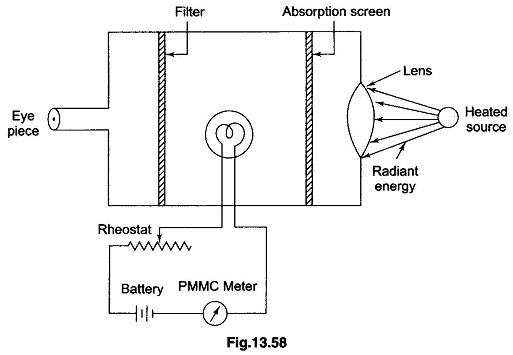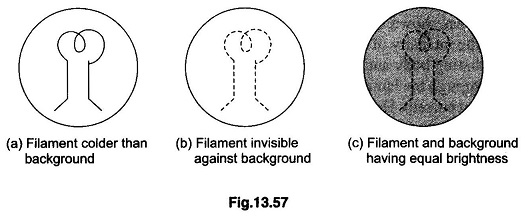Optical Pyrometer Working Principle:
Optical Pyrometer Working Principle – Any metallic surface when heated emits radiation of different wavelengths which are not visible at low temperature but at about 550 °C, radiations in shorter wavelength are visible to eye and from the colour approximate temperature is measured. The approximate values of temperature for colour (colour scale) is given in Table 13.4.
The radiations from a heated body at high temperature fall within the visible region of the EM spectrum. For a given wavelength in the visible region the energy radiated is greater than at higher temperature.
Within a visible range, a given wavelength has a fixed colour and the energy of radiation is interpreted as Intensity or Brightness. Hence if we measure the brightness of the light of a given colour emitted by a hot source, we have an indication of temperature. This is the principle of optical pyrometer.
In an optical pyrometer, the wavelength of radiation accepted is restricted by means of a colour filter and brightness is measured by comparison with a standard lamp.
The most common type of optical pyrometer working principle used is the disappearing filament pyrometer. The schematic is shown in Fig.13.58.
An image of the radiating source is produced by a lens and made to coincide with the filament of an electric lamp.
The current through the lamp filament is made variable so that the lamp intensity can be adjusted. The filament is viewed through an eye piece and filters. The current through the filament is adjusted until the filament and the images are of equal brightness.
When brightness of image produced by the source and brightness produced by the filament are equal, the outline of the filament disappears as shown in Fig.13.57(c ).
However, if the temperature of the filament is higher than that required for equality of brightness, filament becomes too bright as shown in Fig.13.57(b).
On the other hand if the temperature of filament is lower, the filament becomes dark as shown in Fig.13.57(a).
Since the intensity of light of any wavelength depends upon the temperature of the radiating body and the temperature of filament depends upon the current flowing through the lamp. The instrument may be directly calibrated in terms of the filament current. However, the filament current depends upon the resistance of the filament, modern pyrometers are calibrated in terms of resistance directly.
The range of temperature, which can be measured by an instrument of this type depends on the maximum allowable temperature of the lamp which is around 1400 °C.
The range can be extended by using an absorption type screen placed near the objective lens. Hence a known fraction of radiant energy enters the pyrometer for comparison. The range can be extended to 3000 °C by this technique.
Optical Pyrometer working principle is widely used for accurate measurement of temperature of furnaces, molten metals and other heated materials.


